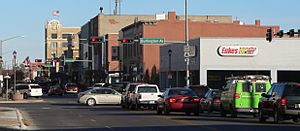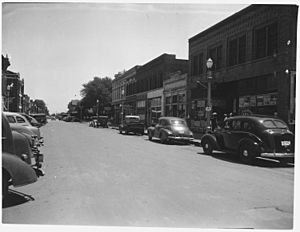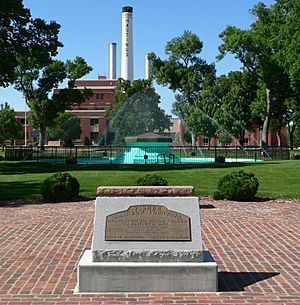Hastings, Nebraska facts for kids
Quick facts for kids
Hastings, Nebraska
|
|
|---|---|

Downtown Hastings: 2nd Street, looking eastward, November 2012
|
|

|
|
| Country | United States |
| State | Nebraska |
| County | Adams |
| Area | |
| • Total | 15.05 sq mi (38.97 km2) |
| • Land | 14.87 sq mi (38.51 km2) |
| • Water | 0.18 sq mi (0.46 km2) |
| Elevation | 1,926 ft (587 m) |
| Population
(2020)
|
|
| • Total | 25,152 |
| • Density | 1,691.46/sq mi (653.09/km2) |
| Time zone | UTC−6 (CST) |
| • Summer (DST) | UTC−5 (CDT) |
| ZIP codes |
68901-68902
|
| Area code | 402 |
| FIPS code | 31-21415 |
| GNIS ID | 838051 |
| U.S. Routes | |
Hastings is a city in Nebraska, United States. It is the main city of Adams County. In 2020, about 25,152 people lived there. This makes it the 8th largest city in Nebraska.
A famous drink called Kool-Aid was invented in Hastings in 1927 by Edwin Perkins. The city celebrates this invention every August with a fun event called Kool-Aid Days.
During World War II, Hastings had the biggest Naval Ammunition Depot (a place to store weapons) in the United States. Because of its important role, it was named an American World War II Heritage City in 2023.
Contents
History of Hastings
How Hastings Began
Hastings started in 1872. It was built where two important railroads met: the Burlington and Missouri River Railroad and the St. Joseph and Denver City Railroad. The city was named after Colonel D. T. Hastings, who helped build the railroad in Adams County.
Before the city was built, this area was an open plain. The Donner party, a group of pioneers, passed through here in 1846. A marker in Hastings has words from one of their journals. It says the land between the Blue and Platte rivers was "beautiful beyond compare."
In the 1870s, railroads encouraged people from Europe to move to Nebraska. Hastings' first settlers were from England. Soon, other people from England, Ireland, Germany, Denmark, and Germans from Russia joined them.
Growth and Challenges
Between 1872 and 1880, Hastings grew very fast. Its population reached 2,800 people. Early settlers lived in simple homes like sod houses and shanties. Then, they built more permanent houses and stores. The city officially became a city in April 1874. In 1878, Hastings became the county seat after a five-year "county seat war."
However, a big fire in 1879 destroyed 33 buildings downtown. The city was rebuilt from 1880 to 1890. New buildings were made from fireproof materials. Many had fancy Victorian designs. Charles C. Rittenhouse, the first architect in Adams County and a ten-year mayor, designed many of them.
Thanks to the railroads, Hastings became very rich during the Gilded Age. The population grew to 13,500. But this growth stopped in the 1890s because of a drought and farming problems. The population dropped to 7,000 and did not reach 15,000 again until 1930.
African Americans have lived in Hastings since the 1860s. In 1876, Horace G. Newsom started Nebraska's first newspaper owned by a Black person.
Hastings in the 20th Century
Hastings started growing again from 1900 to 1930. Many buildings from this time show styles like Craftsman and Colonial Revival. Claude W. Way was a leading architect during this period.
In 1911, Hastings made more bricks than any other city in Nebraska. It also became known for making cigars. The Kipp Cigar Company, the largest factory, made 10 million cigars in 1925. However, cigars became less popular after the 1920s. The Great Depression in the 1930s also slowed the city's growth.
In 1942, the Naval Ammunition Depot (NAD) was built. This caused the city to grow very quickly. Hastings' population jumped from 15,000 to 23,000 in less than a year. There was a big need for more homes. After World War II, the depot reduced its staff. This ended Hastings' growth period in 1950, and the depot later closed. The NAD also greatly increased the number of African American residents in the city.
The Story of Kool-Aid
Kool-Aid was invented by Edwin Perkins in Hastings. He did all his experiments in his mother's kitchen. Before Kool-Aid, he made a liquid drink mix called Fruit Smack. To save money on shipping, Perkins found a way to remove the liquid in 1927. This left only a powder, which he named Kool-Aid.
Perkins moved his production to Chicago in 1931. In 1953, Kool-Aid was sold to General Foods. Hastings still celebrates Kool-Aid with a festival called Kool-Aid Days. It happens every August. Kool-Aid is even known as Nebraska's official soft drink.
Hastings Today
Today, some of Hastings' oldest neighborhoods, Heartwell Park and Central Hastings, are listed on the National Register of Historic Places. The Hastings Symphony Orchestra performs at the Chautauqua Pavilion, built in 1907.
Many historic buildings in the city have found new uses. Central Community College is now in the buildings of the old Naval Ammunition Depot. St. Michael's Elementary School, built in 1912, is now the police headquarters. The Clarke Hotel, built in 1914, is now a home for senior citizens called the Kensington.
In 2007, Hastings won Yahoo's Greenest City in America competition.
Geography and Climate
Hastings covers about 13.66 square miles (35.38 km2). Most of this area is land, with a small amount of water.
Weather in Hastings
Hastings has a climate with cold, snowy winters and hot, rainy summers. A weather office is located in Hastings. It helps forecast weather for central Nebraska and parts of Kansas.
| Climate data for Hastings, Nebraska (1991–2020 normals, extremes 1894–present) | |||||||||||||
|---|---|---|---|---|---|---|---|---|---|---|---|---|---|
| Month | Jan | Feb | Mar | Apr | May | Jun | Jul | Aug | Sep | Oct | Nov | Dec | Year |
| Record high °F (°C) | 76 (24) |
80 (27) |
90 (32) |
96 (36) |
105 (41) |
110 (43) |
116 (47) |
111 (44) |
105 (41) |
97 (36) |
86 (30) |
80 (27) |
116 (47) |
| Mean maximum °F (°C) | 59.5 (15.3) |
65.2 (18.4) |
76.7 (24.8) |
85.2 (29.6) |
91.4 (33.0) |
96.6 (35.9) |
99.1 (37.3) |
96.9 (36.1) |
93.4 (34.1) |
86.1 (30.1) |
73.6 (23.1) |
60.8 (16.0) |
100.4 (38.0) |
| Mean daily maximum °F (°C) | 35.9 (2.2) |
40.3 (4.6) |
52.6 (11.4) |
62.8 (17.1) |
72.9 (22.7) |
83.5 (28.6) |
87.4 (30.8) |
85.0 (29.4) |
78.5 (25.8) |
65.2 (18.4) |
50.6 (10.3) |
38.5 (3.6) |
62.7 (17.1) |
| Daily mean °F (°C) | 25.7 (−3.5) |
29.5 (−1.4) |
40.4 (4.7) |
50.5 (10.3) |
61.5 (16.4) |
72.2 (22.3) |
76.4 (24.7) |
73.8 (23.2) |
66.1 (18.9) |
52.8 (11.6) |
39.2 (4.0) |
28.5 (−1.9) |
51.3 (10.7) |
| Mean daily minimum °F (°C) | 15.4 (−9.2) |
18.7 (−7.4) |
28.2 (−2.1) |
38.2 (3.4) |
50.1 (10.1) |
60.8 (16.0) |
65.3 (18.5) |
62.9 (17.2) |
53.7 (12.1) |
40.5 (4.7) |
27.8 (−2.3) |
18.6 (−7.4) |
40.0 (4.4) |
| Mean minimum °F (°C) | −5.8 (−21.0) |
−1.3 (−18.5) |
8.3 (−13.2) |
22.9 (−5.1) |
35.3 (1.8) |
49.1 (9.5) |
54.8 (12.7) |
52.3 (11.3) |
38.7 (3.7) |
23.1 (−4.9) |
10.4 (−12.0) |
−0.9 (−18.3) |
−10.3 (−23.5) |
| Record low °F (°C) | −30 (−34) |
−30 (−34) |
−15 (−26) |
5 (−15) |
22 (−6) |
34 (1) |
45 (7) |
40 (4) |
26 (−3) |
4 (−16) |
−7 (−22) |
−23 (−31) |
−30 (−34) |
| Average precipitation inches (mm) | 0.61 (15) |
0.80 (20) |
1.36 (35) |
2.98 (76) |
4.48 (114) |
3.74 (95) |
3.58 (91) |
3.37 (86) |
2.16 (55) |
1.97 (50) |
1.21 (31) |
0.86 (22) |
26.54 (674) |
| Average snowfall inches (cm) | 6.8 (17) |
7.5 (19) |
3.8 (9.7) |
1.7 (4.3) |
0.0 (0.0) |
0.0 (0.0) |
0.0 (0.0) |
0.0 (0.0) |
0.0 (0.0) |
1.1 (2.8) |
2.3 (5.8) |
5.6 (14) |
28.4 (72) |
| Average precipitation days (≥ 0.01 in.) | 5.3 | 5.6 | 7.3 | 9.2 | 12.2 | 10.2 | 8.9 | 9.7 | 7.0 | 6.9 | 5.2 | 5.1 | 91.0 |
| Average snowy days (≥ 0.1 in.) | 4.6 | 4.7 | 2.8 | 1.1 | 0.1 | 0.0 | 0.0 | 0.0 | 0.0 | 0.5 | 1.8 | 4.1 | 19.7 |
| Source: NOAA | |||||||||||||
People in Hastings
| Historical population | |||
|---|---|---|---|
| Census | Pop. | %± | |
| 1880 | 2,817 | — | |
| 1890 | 13,584 | 382.2% | |
| 1900 | 7,188 | −47.1% | |
| 1910 | 9,338 | 29.9% | |
| 1920 | 11,647 | 24.7% | |
| 1930 | 15,490 | 33.0% | |
| 1940 | 15,145 | −2.2% | |
| 1950 | 20,211 | 33.4% | |
| 1960 | 21,412 | 5.9% | |
| 1970 | 23,580 | 10.1% | |
| 1980 | 23,045 | −2.3% | |
| 1990 | 22,837 | −0.9% | |
| 2000 | 24,064 | 5.4% | |
| 2010 | 24,907 | 3.5% | |
| 2020 | 25,152 | 1.0% | |
| U.S. Decennial Census | |||
Hastings is the main city of the Hastings, Nebraska Micropolitan Statistical Area. This area includes Adams and Clay counties.
2020 Population Details
The 2020 United States census counted 25,152 people in Hastings. There were 10,137 households. About 83.16% of the people were white. About 13.0% were Hispanic or Latino.
About 28.1% of households had children under 18. The average household had 2.3 people. The average family had 3.0 people. The median age in the city was 36.0 years.
Getting Around Hastings
Amtrak, the national passenger train system, has a station in Hastings. The California Zephyr train stops here daily. It travels between Chicago and San Francisco.
Major highways serve Hastings. These include U.S. Highways 6 and 34 (east-west). Also, U.S. Highway 281 runs north-south. Burlington Avenue is the main street going north and south. Hastings is about 14 miles (23 km) south of Interstate 80.
The Hastings Municipal Airport is owned and run by the city. It serves the area.
Schools and Colleges
The main school district is the Hastings Public Schools. Hastings has several elementary schools, including Alcott, Hawthorne, Watson, and Lincoln. Zion Classical Academy serves students from preschool to 8th grade. A new middle school opened in 2008.
The public high school is Hastings High School. There is also a Catholic high school called St. Cecilia's. Just outside town is Adams Central Junior-Senior High School.
Hastings College is a private college founded in 1882. It is connected to the Presbyterian Church. Central Community College is a two-year technical college. It started in 1966 and is located at the old Naval Ammunition Depot site.
Fisher Fountain
The Jacob Fisher Rainbow Fountain is in Highland Park. It shoots water jets up to 67 feet high. Green, yellow, orange, red, magenta, and blue lights shine on the water. This creates changing patterns.
The fountain started as a temporary display in 1932. It was called the Electric Fountain. It became a sign of hope during the Great Depression and Dust Bowl. Because it was so popular, it was moved to the park and made permanent. Schoolchildren helped rename it. They combined two winning names: Rainbow Fountain and Fisher Fountain, after Mayor Jacob Fisher.
The fountain was fixed up in 1982. But in 1984, vandals blew it up. The community was very upset. People raised $63,000 to rebuild it. It was opened again on Mother's Day in 1985.
Hastings Museum
The Hastings Museum of Natural and Cultural History is in an art deco building. It was finished in 1939. Albert Brooking started the museum in 1926. He gave it many items, like Native American relics and fossils. He also had the largest private collection of mounted birds in the U.S.
Today, the museum has the Lied Super Screen Theatre and the McDonald Planetarium. It also has local exhibits. One exhibit shows the largest display of whooping and sandhill cranes in the world. The Adams County Historical Society is also located inside the museum.
The Naval Ammunition Depot was built southeast of Hastings. It was open from 1942 to 1946. It was the largest U.S. World War II naval weapons plant. It had over 2,200 buildings. Hastings was chosen because of its central location. In 1945, it employed almost 7,000 civilians and many military members.
The plant was used again during the Korean War. But it was closed between 1958 and 1966. Now, the site has a U.S. Department of Agriculture research station. It also has training places for the National Guard, an industrial park, Central Community College, and a golf course.
Parks and Fun Activities
Hastings has twenty parks and places for recreation. The city offers fun programs. It runs the Aquacourt Water Park, the City Auditorium, and Lake Hastings. Other places include Chautauqua Pavilion, Duncan Field, and the Pioneer Spirit Trail. There is also the Smith Softball Complex and Brickyard Park Amphitheater.
Media in Hastings
The main newspaper in Hastings is the Hastings Tribune. It is published six days a week.
The studio for KNHL television is located north of Hastings on U.S. 281.
Famous People from Hastings
- Marc Boerigter, football player
- Stan Campbell, football player
- Adam Carriker, football player
- Sandy Dennis, actress who won an Academy Award
- Neal Hefti, jazz musician and composer
- Sheila Hicks, fiber artist
- Johnny Hopp, Major League baseball player
- Rollin Kirby, political cartoonist
- Gwen Lee, stage and film actress
- Les Nunamaker, Major League baseball player
- Tom Osborne, University of Nebraska football coach and Congressman
- Edwin Perkins, inventor of Kool-Aid
- Fred A. Seaton, U.S. Secretary of the Interior
- Rick Sheehy, lieutenant governor of Nebraska
- Zach Sterup, football player
See also
 In Spanish: Hastings (Nebraska) para niños
In Spanish: Hastings (Nebraska) para niños



